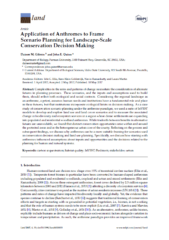
Complexities in the rates and patterns of change necessitate the consideration of alternate futures in planning processes. These scenarios, and the inputs and assumptions used to build them, should reflect both ecological and social contexts. Considering the regional landscape as an anthrome, a priori, assumes human needs and institutions have a fundamental role and place in these futures, but that institutions incorporate ecological limits in decision making.
As a case study of conservation scenario planning under the anthrome paradigm, we used a suite of InVEST models to develop and explore land use and land cover scenarios and to measure the associated change in biodiversity and ecosystem services in a region where dense settlements are expanding into populated and residential woodland anthromes. While tradeoffs between benefits in alternative futures are unavoidable, we found that distinct conservation opportunities arise within and around the protected areas and in the heterogeneous urban core of the county.
Reflecting on the process and subsequent findings, we discuss why anthromes can be a more suitable framing for scenarios used in conservation decision making and land use planning. Specifically, we discuss how starting with anthromes influenced assumptions about inputs and opportunities and the decisions related to the planning for human and natural systems.
